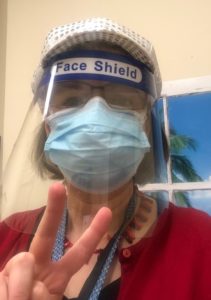
For my first 20-plus years as a long-term care psychologist, I arrived on the job wearing not just clothes, but outfits. I chose garb that contributed to the sense of “expertness, attractiveness, and trustworthiness” that psychologists were supposed to engender in their patients.
Sometimes I wore pantsuits or dresses, more often skirts or slacks with coordinating sweaters, jewelry, and eye shadow. Pumps or heeled boots in the winter, open-back wedges in the summer. In my mind, I had an obligation to the residents to be a mini-fashion show, a break from the monotony of uniforms. I was fancy.
Then came the pandemic.
The surgical masks arrived, then the surge, followed by N95s, face shields, and clothing that could be immediately stripped, bagged, and tossed in the wash after every wear.
Heels became absurd. Outfits? In the middle of a pandemic? No.
At first, I wore hideous sneakers I found in the back of the closet from when I used to go to the gym before starting a family. Then I switched to blue clogs.
Did you hear the angels sing when I mentioned the blue clogs or was that just me? It was the angels lauding the comfort of clogs over heeled shoes.
I wore pants I didn’t care about much and ordered my first pair of scrubs online. They were a bit large, but they had pockets, lots of pockets. Angels sing about pockets too.

It was a miserable time in the nursing home. I added a signature flashy disco hat to combat the misery and to distinguish myself from coworkers who were equally enveloped in PPE.
I was no longer dressing to engender perceptions of expertness, attractiveness, and trustworthiness. My patients loved me just the same.
I conducted entire episodes of care with people who never knew what I actually looked like. They came and went, telling their deepest secrets to someone whose eyes were under a face shield, whose expressions were hidden beneath layers of masks, whose temples dripped with perspiration after hours in PPE.
I was their port in the storm. They looked for a disco-hatted lady who could now pass them on the street undetected. The circumstances were extreme enough and, apparently, I was trustworthy enough despite the clothes I was wearing.
One year later, the hat has been retired, along with the face shield and the N95s. I’m still wearing the surgical mask, along with a colorful wardrobe of scrub pants and my blue clogs, which I recently re-soled. I started coordinating my jewelry again.
The good thing about scrubs, aside from the pockets, is that they were forgiving of my mid-pandemic weight gain and they’ve been forgiving of my late-pandemic weight loss. The good thing about clogs, aside from the way they look, is everything.
I’ve given so much to my job over the past year and a half, the ease of my clothing is one way of giving something back to me.
Will I ever again show up at the nursing home looking fancy? I don’t know.
I won’t try to forecast how I’ll feel about my attire in the future. If there’s anything I’ve learned from the pandemic, it’s that life can be unpredictable.
Eleanor Feldman Barbera, Ph.D., author of The Savvy Resident’s Guide, is an Award of Excellence winner in the Blog Content category of the APEX Awards for Publication Excellence program. She also is a Bronze Medalist for Best Blog in the American Society of Business Publication Editors national competition and a Gold Medalist in the Blog-How To/Tips/Service category in their Midwest Regional competition. To contact her for speaking engagements and/or content writing, visit her at EleanorFeldmanBarbera.com.





